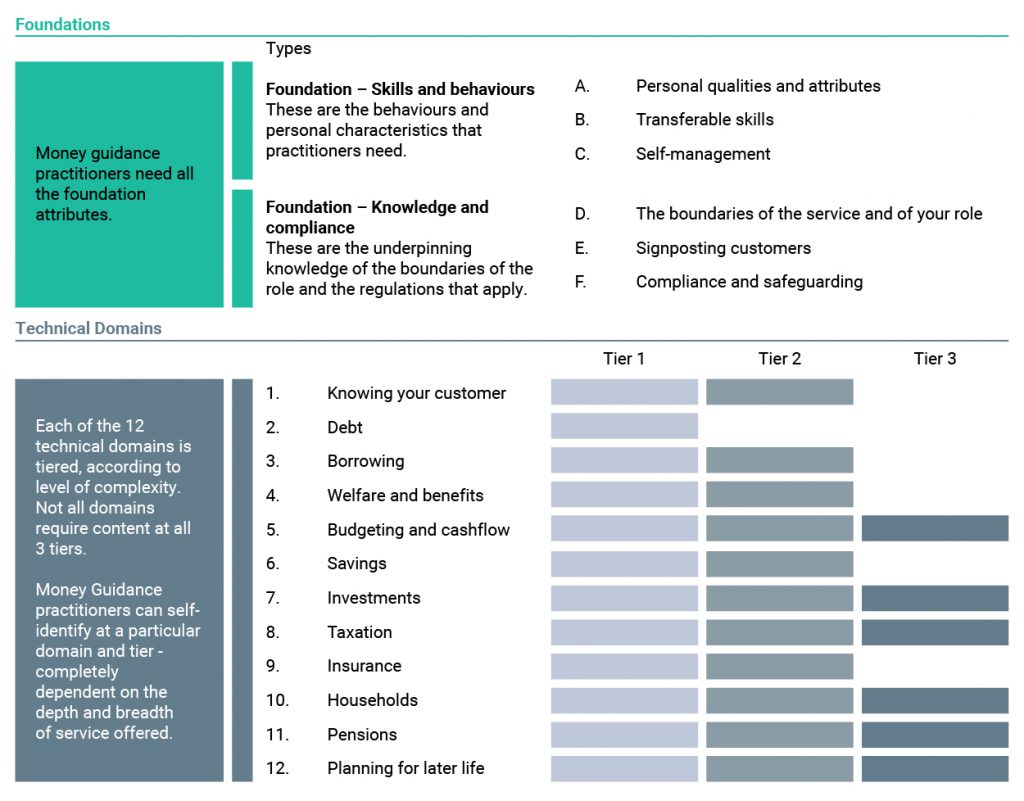Technical domains tier descriptions
These are the 12 money domains, each of which are founded on technical knowledge.
The domains are all tiered, according to the level of complexity at which the practitioner works.

There is a maximum of three tiers, though not all domains require skills or knowledge at every level.
- Tier 1: At this level, practitioners provide people with factual information (or access to the information) which enables them to do more about their own situation. They have a general awareness of other services or resources that might be able to offer further help and advice, and part of this role involves signposting people to these. They may also explain terminology or provide clarification of a document (such as a bank statement). Tier 1 practitioners do not provide information or guidance tailored to an individual’s circumstances, but generalist information which they can act on.
- Tier 2: At this level, practitioners focus on the individual circumstances of the people they help, exploring their needs, setting out options available to them and identifying the implications and consequences of any action. The practitioner may see the same customer/s on an ongoing basis and may offer practical assistance with interpreting letters and forms. As well as signposting people to other sources and agencies, the practitioner might also formally refer people to other organisations. At this level, the practitioner may offer some coaching to improve the financial capability and money management skills of the people they help.
- Tier 3: This focuses on specialist areas of bespoke information provision. At this level, practitioners will likely specialise in a particular area such as pensions. This naturally requires them to have an in-depth knowledge of the relevant regulations and organisations as well as the features of specific products and services. They will have very well-developed questioning and listening skills, and the confidence to deal with complex cases. Practitioners at Tier 3 may also be involved in case-work.
All domains and tiers can be self-identified, a practitioner could choose as many or few – completely depending on the depth and breadth of service they provide
No hierarchy is intended across the domains – the ordering of the domains and numbering within each tier is there to help easy recognition and referencing.
Within each domain the tiers provide clear progression. So in order to identify at a tier 2 or 3 in any of the domains, a practitioner must meet all of the competencies in the previous tiers, for that domain.
It is not possible to specify where on the framework particular job titles fit due to the varied roles of those who hold the same job title – take for example the title ‘Volunteer’ which may refer to someone working in a library who signposts people to appropriate sources for further information or, to someone working on a voluntary basis who provides in-depth guidance as a result of their qualifications, knowledge and experience.
Commonly used terms
The framework – particularly the technical domains – frequently refer to the money guidance practitioner having ‘awareness’, ‘knowledge’ or ‘understanding’. These three frequently used terms have been defined below for the purposes of this framework:
- Awareness – Refers to an individual’s knowledge that something exists
- Knowledge – Refers to an individual’s theoretical or practical understanding of a subject
- Understanding – Refers to an individual’s comprehension – their ability to know how something works and/or what it means.
